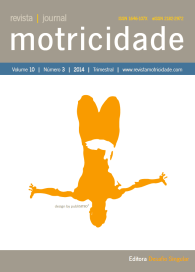Adaptation behavior of skilled infant bouncers to different spring frequencies
DOI:
https://doi.org/10.6063/motricidade.2944Resumo
Infants explore their environments through repetitive movements that are constrained or facilitated by the environmental context. In this study, we evaluated how skilled bouncers adapted to bouncing in systems with four different spring conditions (natural frequencies of 0.9, 1.15, 1.27 and 1.56 Hz). Trunk kinematics and vertical ground reaction forces (VGRFs) were recorded from three pre-walking infants (mean age 10.6 ±0.9 months). Bounce frequency, trunk displacement, peak VGRF, percent of time on the ground and time to peak force as a function of time on the ground were analyzed. In addition, infant bounce frequencies were compared to measured oscillations of an inert mass equivalent to each infant’s mass. All infants bounced above the natural frequency of the spring system in all conditions suggesting that they did not behave solely like mass-spring systems. Infants produced asymmetrical VGRF loading patterns suggesting that a timing component, such as bounce frequency, was regulated. Skilled infants consistently increased their bounce frequency as their vertical trunk displacement decreased; however, the mode for regulating bounce frequency differed from infant to infant.
Downloads
Publicado
Edição
Secção
Licença
Os autores dos manuscritos submetidos para publicação deverão ceder, a título integral e permanente, os direitos de autor (copyright) à revista Motricidade e às Edições Sílabas Didáticas. A cedência de direitos de autor permite a publicação e divulgação do artigo em formato impresso ou eletrónico e entrará em vigor a partir da data de aceitação do manuscrito. Os autores concedem, ainda, os direitos para a revista Motricidade utilizar e explorar o respetivo artigo, nomeadamente para licenciar, ceder ou vender o seu conteúdo a bases de resumos/indexação ou outras entidades.
Nos termos da licença “Creative Commons”, os autores poderão reproduzir um número razoável de exemplares para uso pessoal ou profissional, mas sem fins comerciais. Nos termos da licença SHERPA/RoMEO, os autores poderão, ainda, disponibilizar/arquivar uma cópia digital final (versão postprint) do artigo no seu website ou no repositório científico da sua instituição.


